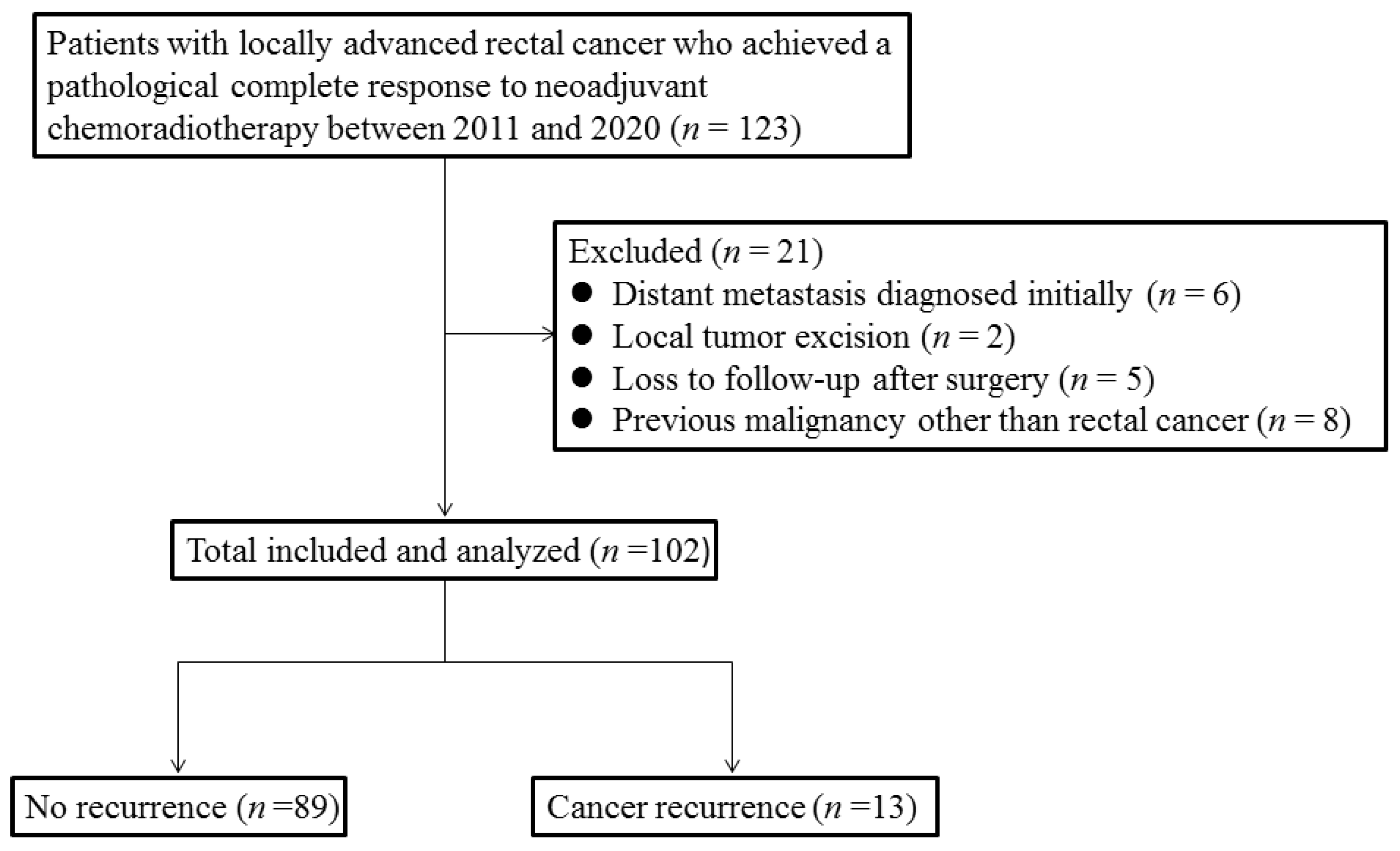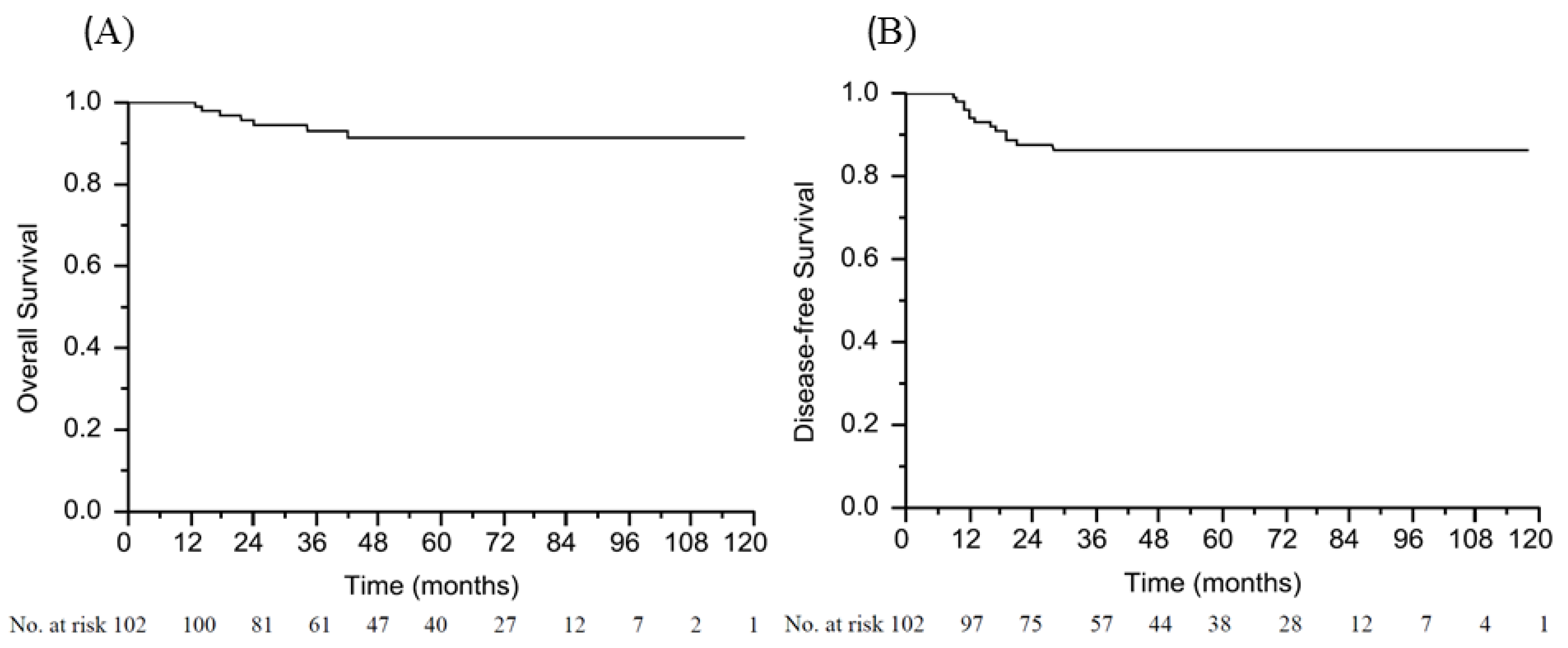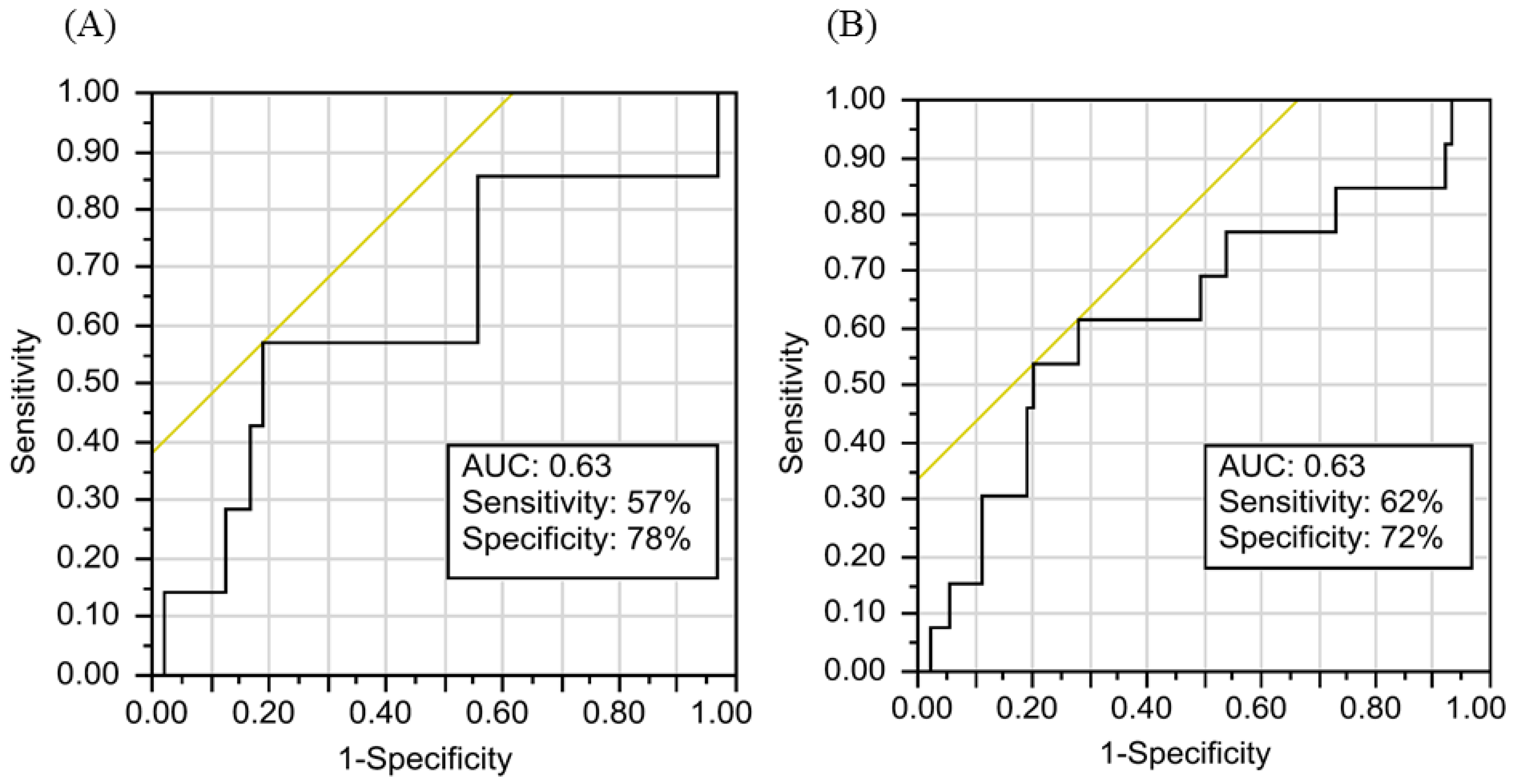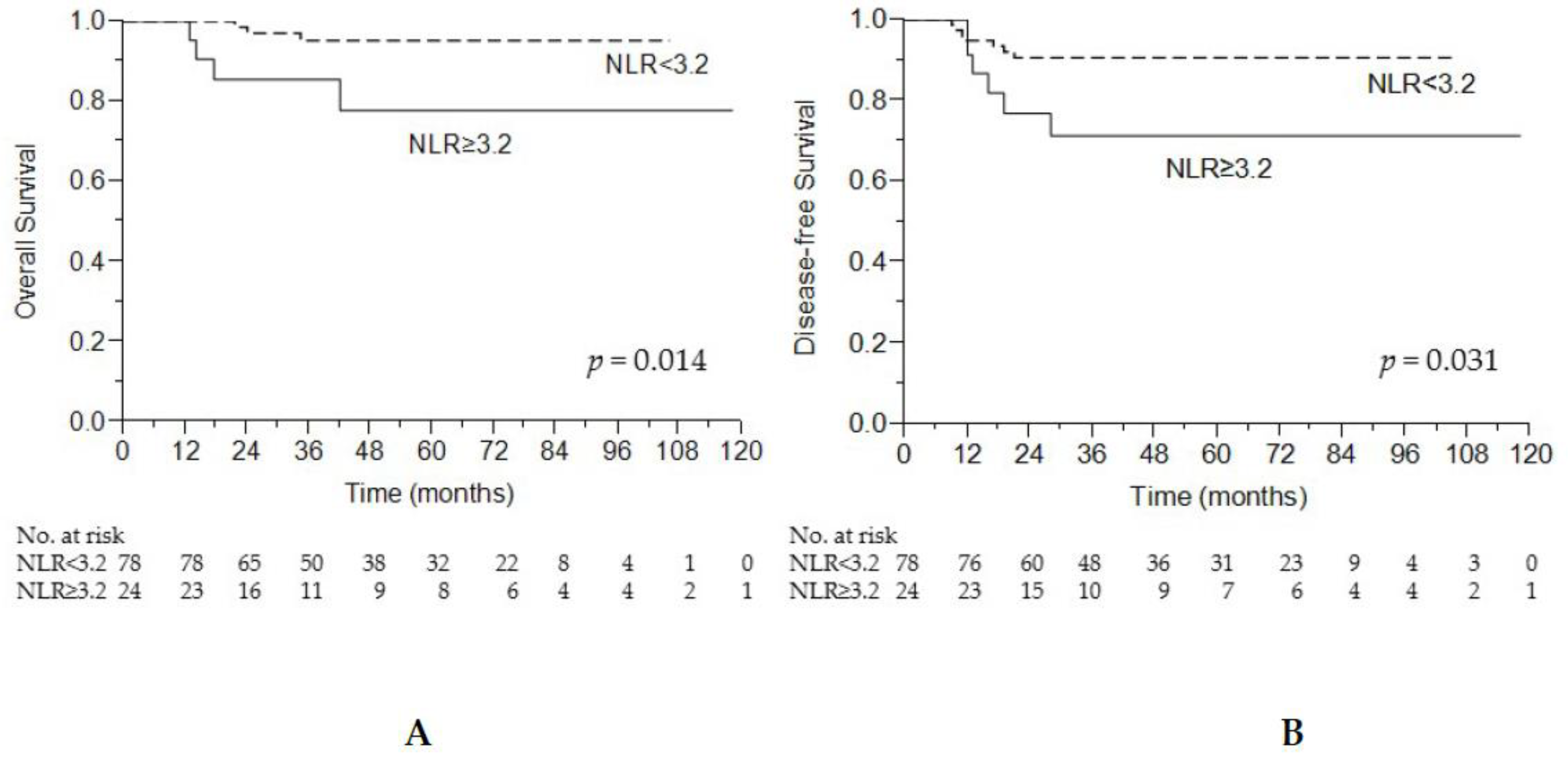Pretreatment Neutrophil-to-Lymphocyte Ratio Associated with Tumor Recurrence and Survival in Patients Achieving a Pathological Complete Response Following Neoadjuvant Chemoradiotherapy for Rectal Cancer
Abstract
:Simple Summary
Abstract
1. Introduction
2. Materials and Methods
2.1. Ethics Approval Statement
2.2. Patient Selection
2.3. Treatment
2.4. Evaluation and Follow-Up
2.5. Statistical Analysis
3. Results
3.1. Patient Characteristics
3.2. Oncological Outcomes among Patients with pCR
3.3. Optimal NLR Cutoff
3.4. Association between NLR Level and Clinical Variables
3.5. Association between NLR Level and Survival Outcomes
4. Discussion
5. Conclusions
Author Contributions
Funding
Institutional Review Board Statement
Informed Consent Statement
Data Availability Statement
Conflicts of Interest
References
- van Gijn, W.; Marijnen, C.A.; Nagtegaal, I.D.; Kranenbarg, E.M.; Putter, H.; Wiggers, T.; Rutten, H.J.; Påhlman, L.; Glimelius, B.; van de Velde, C.J. Preoperative radiotherapy combined with total mesorectal excision for resectable rectal cancer: 12-year follow-up of the multicentre, ran-domised controlled TME trial. Lancet Oncol. 2011, 12, 575–582. [Google Scholar] [CrossRef]
- Sauer, R.; Becker, H.; Hohenberger, W.; Rödel, C.; Wittekind, C.; Fietkau, R.; Martus, P.; Tschmelitsch, J.; Hager, E.; Hess, C.F.; et al. Preoperative versus postoperative chemoradiotherapy for rectal cancer. N. Engl. J. Med. 2004, 351, 1731–1740. [Google Scholar] [CrossRef] [Green Version]
- Capirci, C.; Valentini, V.; Cionini, L.; De Paoli, A.; Rodel, C.; Glynne-Jones, R.; Coco, C.; Romano, M.; Mantello, G.; Palazzi, S.; et al. Prognostic value of pathologic complete response after neoadjuvant therapy in locally advanced rectal cancer: Long-term analysis of 566 ypCR patients. Int. J. Radiat. Oncol. Biol. Phys. 2008, 72, 99–107. [Google Scholar] [CrossRef] [PubMed]
- Zorcolo, L.; Rosman, A.S.; Restivo, A.; Pisano, M.; Nigri, G.R.; Fancellu, A.; Melis, M. Complete pathologic response after combined modality treatment for rectal cancer and long-term survival: A meta-analysis. Ann. Surg. Oncol. 2012, 19, 2822–2832. [Google Scholar] [CrossRef]
- Fan, W.H.; Xiao, J.; An, X.; Jiang, W.; Li, L.R.; Gao, Y.H.; Chen, G.; Kong, L.H.; Lin, J.Z.; Wang, J.P.; et al. Patterns of recurrence in patients achieving pathologic complete response after neoadjuvant chemoradiotherapy for rectal cancer. J. Cancer Res. Clin. Oncol. 2017, 143, 1461–1467. [Google Scholar] [CrossRef] [Green Version]
- Smith, K.D.; Tan, D.; Das, P.; Chang, G.J.; Kattepogu, K.; Feig, B.W.; Skibber, J.M.; Rodri-guez-Bigas, M.A. Clinical significance of acellular mucin in rectal adenocarcinoma patients with a pathologic complete response to preoperative chemoradiation. Ann. Surg. 2010, 251, 261–264. [Google Scholar] [CrossRef]
- Maas, M.; Nelemans, P.J.; Valentini, V.; Das, P.; Rödel, C.; Kuo, L.J.; Calvo, F.A.; Gar-cía-Aguilar, J.; Glynne-Jones, R.; Haustermans, K.; et al. Long-term outcome in patients with a pathological complete response after chemoradiation for rectal cancer: A pooled analysis of indi-vidual patient data. Lancet Oncol. 2010, 11, 835–844. [Google Scholar] [CrossRef]
- Chu, H.H.; Kim, J.H.; Shim, J.H.; Gwon, D.I.; Ko, H.K.; Shin, J.H.; Ko, G.Y.; Yoon, H.K.; Kim, N. Neutrophil-to-Lymphocyte Ratio as a Biomarker Predicting Overall Survival after Che-moembolization for Intermediate-Stage Hepatocellular Carcinoma. Cancers 2021, 13, 2830. [Google Scholar] [CrossRef]
- Stotz, M.; Gerger, A.; Eisner, F.; Szkandera, J.; Loibner, H.; Ress, A.L.; Kornprat, P.; Al-Zoughbi, W.; Seggewies, F.S.; Lackner, C.; et al. Increased neutrophil-lymphocyte ratio is a poor prognostic factor in patients with primary operable and inoperable pancreatic cancer. Br. J. Cancer 2013, 109, 416–421. [Google Scholar] [CrossRef] [PubMed] [Green Version]
- Yu, Y.; Wang, H.; Yan, A.; Wang, H.; Li, X.; Liu, J.; Li, W. Pretreatment neutrophil to lymphocyte ratio in determining the prognosis of head and neck cancer: A meta-analysis. BMC Cancer 2018, 18, 383. [Google Scholar] [CrossRef] [PubMed]
- Roxburgh, C.S.; Salmond, J.M.; Horgan, P.G.; Oien, K.A.; McMillan, D.C. The relationship between the local and systemic inflammatory responses and survival in patients undergoing cura-tive surgery for colon and rectal cancers. J. Gastrointest. Surg. 2009, 13, 2011–2018, discussion 2018–2019. [Google Scholar] [CrossRef] [PubMed]
- Chua, W.; Charles, K.A.; Baracos, V.E.; Clarke, S.J. Neutrophil/lymphocyte ratio predicts chemotherapy outcomes in patients with advanced colorectal cancer. Br. J. Cancer 2011, 104, 1288–1295. [Google Scholar] [CrossRef] [Green Version]
- Dell’Aquila, E.; Cremolini, C.; Zeppola, T.; Lonardi, S.; Bergamo, F.; Masi, G.; Stellato, M.; Marmorino, F.; Schirripa, M.; Urbano, F.; et al. Prognostic and predictive role of neutro-phil/lymphocytes ratio in metastatic colorectal cancer: A retrospective analysis of the TRIBE study by GONO. Ann. Oncol. 2018, 29, 924–930. [Google Scholar] [CrossRef]
- Shamamian, P.; Schwartz, J.D.; Pocock, B.J.; Monea, S.; Whiting, D.; Marcus, S.G.; Mignatti, P. Activation of progelatinase A (MMP-2) by neutrophil elastase, cathepsin G, and proteinase-3: A role for inflammatory cells in tumor invasion and angiogenesis. J. Cell. Physiol. 2001, 189, 197–206. [Google Scholar] [CrossRef] [PubMed]
- Motomura, T.; Shirabe, K.; Mano, Y.; Muto, J.; Toshima, T.; Umemoto, Y.; Fukuhara, T.; Uchiyama, H.; Ikegami, T.; Yoshizumi, T.; et al. Neutrophil-lymphocyte ratio reflects hepatocellular carcinoma recurrence after liver transplantation via inflammatory microenvironment. J. Hepatol. 2013, 58, 58–64. [Google Scholar] [CrossRef]
- Fogar, P.; Sperti, C.; Basso, D.; Sanzari, M.C.; Greco, E.; Davoli, C.; Navaglia, F.; Zambon, C.F.; Pasquali, C.; Venza, E.; et al. Decreased total lymphocyte counts in pancreatic cancer: An index of adverse outcome. Pancreas 2006, 32, 22–28. [Google Scholar] [CrossRef] [PubMed]
- Shen, L.; Zhang, H.; Liang, L.; Li, G.; Fan, M.; Wu, Y.; Zhu, J.; Zhang, Z. Baseline neutro-phil-lymphocyte ratio (≥2.8) as a prognostic factor for patients with locally advanced rectal cancer undergoing neoadjuvant chemoradiation. Radiat. Oncol. 2014, 9, 295. [Google Scholar] [CrossRef] [Green Version]
- Nagasaki, T.; Akiyoshi, T.; Fujimoto, Y.; Konishi, T.; Nagayama, S.; Fukunaga, Y.; Ueno, M. Prognostic Impact of Neutrophil-to-Lymphocyte Ratio in Patients with Advanced Low Rectal Cancer Treated with Preoperative Chemoradiotherapy. Dig. Surg. 2015, 32, 496–503. [Google Scholar] [CrossRef]
- Park, I.J.; Yu, C.S.; Lim, S.B.; Lee, J.L.; Kim, C.W.; Yoon, Y.S.; Park, S.H.; Kim, J.C. Is Pre-operative Chemoradiotherapy Beneficial for Sphincter Preservation in Low-Lying Rectal Cancer Patients? Medicine 2016, 95, e3463. [Google Scholar] [CrossRef]
- Huang, C.M.; Huang, M.Y.; Tsai, H.L.; Huang, C.W.; Ma, C.J.; Yeh, Y.S.; Juo, S.H.; Huang, C.J.; Wang, J.Y. An observational study of extending FOLFOX chemotherapy, lengthening the in-terval between radiotherapy and surgery, and enhancing pathological complete response rates in rectal cancer patients following preoperative chemoradiotherapy. Ther. Adv. Gastroenterol. 2016, 9, 702–712. [Google Scholar] [CrossRef] [Green Version]
- Huang, C.M.; Huang, C.W.; Ma, C.J.; Yeh, Y.S.; Su, W.C.; Chang, T.K.; Tsai, H.L.; Juo, S.H.; Huang, M.Y.; Wang, J.Y. Predictive Value of FOLFOX-Based Regimen, Long Interval, Hemoglobin Levels and Clinical Negative Nodal Status, and Postchemoradiotherapy CEA Levels for Patholog-ical Complete Response in Patients with Locally Advanced Rectal Cancer after Neoadjuvant Chemoradiotherapy. J. Oncol. 2020, 2020, 9437684. [Google Scholar]
- Huang, C.M.; Huang, M.Y.; Huang, C.W.; Tsai, H.L.; Su, W.C.; Chang, W.C.; Wang, J.Y.; Shi, H.Y. Machine learning for predicting pathological complete response in patients with locally advanced rectal cancer after neoadjuvant chemoradiotherapy. Sci. Rep. 2020, 10, 12555. [Google Scholar] [CrossRef]
- Sun, Y.; Wu, X.; Zhang, Y.; Lin, H.; Lu, X.; Huang, Y.; Chi, P. Pathological complete response may underestimate distant metastasis in locally advanced rectal cancer following neoadjuvant chemoradiotherapy and radical surgery: Incidence, metastatic pattern, and risk factors. Eur. J. Surg. Oncol. 2019, 45, 1225–1231. [Google Scholar] [CrossRef]
- Dossa, F.; Acuna, S.A.; Rickles, A.S.; Berho, M.; Wexner, S.D.; Quereshy, F.A.; Baxter, N.N.; Chadi, S.A. Association Between Adjuvant Chemotherapy and Overall Survival in Patients With Rectal Cancer and Pathological Complete Response after Neoadjuvant Chemotherapy and Resection. JAMA Oncol. 2018, 4, 930–937. [Google Scholar] [CrossRef] [PubMed] [Green Version]
- Ma, B.; Ren, Y.; Chen, Y.; Lian, B.; Jiang, P.; Li, Y.; Shang, Y.; Meng, Q. Is adjuvant chemotherapy necessary for locally advanced rectal cancer patients with pathological complete response after neoadjuvant chemoradiotherapy and radical surgery? A systematic review and meta-analysis. Int. J. Colorectal Dis. 2019, 34, 113–121. [Google Scholar] [CrossRef]
- Hu, X.; Li, Y.Q.; Ma, X.J.; Zhang, L.; Cai, S.J.; Peng, J.J. Adjuvant chemotherapy for rectal cancer with complete pathological response (pCR) may not be necessary: A pooled analysis of 5491 patients. Cancer Cell Int. 2019, 19, 127. [Google Scholar] [CrossRef]
- Cercek, A.; Roxburgh, C.S.D.; Strombom, P.; Smith, J.J.; Temple, L.K.F.; Nash, G.M.; Guillem, J.G.; Paty, P.B.; Yaeger, R.; Stadler, Z.K.; et al. Adoption of Total Neoadjuvant Therapy for Locally Advanced Rectal Cancer. JAMA Oncol. 2018, 4, e180071. [Google Scholar] [CrossRef]
- Kasi, A.; Abbasi, S.; Handa, S.; Al-Rajabi, R.; Saeed, A.; Baranda, J.; Sun, W. Total Neoadjuvant Therapy vs Standard Therapy in Locally Advanced Rectal Cancer: A Systematic Review and Meta-analysis. JAMA Netw. Open 2020, 3, e2030097. [Google Scholar] [CrossRef]
- van der Valk, M.J.M.; Marijnen, C.A.M.; van Etten, B.; Dijkstra, E.A.; Hilling, D.E.; Kranenbarg, E.M.; Putter, H.; Roodvoets, A.G.H.; Bahadoer, R.R.; Fokstuen, T.; et al. Compliance and tolerability of short-course radiotherapy followed by preoperative chemotherapy and surgery for high-risk rectal cancer—Results of the international randomized RAPIDO-trial. Radiother. Oncol. 2020, 147, 75–83. [Google Scholar] [CrossRef] [PubMed]
- Markovina, S.; Youssef, F.; Roy, A.; Aggarwal, S.; Khwaja, S.; DeWees, T.; Tan, B.; Hunt, S.; Myerson, R.J.; Chang, D.T.; et al. Improved Metastasis- and Disease-Free Survival with Preoperative Sequential Short-Course Radiation Therapy and FOLFOX Chemotherapy for Rectal Cancer Compared with Neoadjuvant Long-Course Chemoradiotherapy: Results of a Matched Pair Analysis. Int. J. Radiat. Oncol. Biol. Phys. 2017, 99, 417–426. [Google Scholar] [CrossRef] [PubMed]
- Fridlender, Z.G.; Albelda, S.M. Tumor-associated neutrophils: Friend or foe? Carcinogenesis 2012, 33, 949–955. [Google Scholar] [CrossRef] [PubMed] [Green Version]
- Mishalian, I.; Bayuh, R.; Levy, L.; Zolotarov, L.; Michaeli, J.; Fridlender, Z.G. Tumor-associated neutrophils (TAN) develop pro-tumorigenic properties during tumor progression. Cancer Immunol. Immunother. 2013, 62, 1745–1756. [Google Scholar] [CrossRef] [PubMed]
- Diefenhardt, M.; Hofheinz, R.D.; Martin, D.; Beißbarth, T.; Arnold, D.; Hartmann, A.; von der Grün, J.; Grützmann, R.; Liersch, T.; Ströbel, P.; et al. Leukocytosis and neutrophilia as independent prognostic immunological biomarkers for clinical outcome in the CAO/ARO/AIO-04 randomized phase 3 rectal cancer trial. Int. J. Cancer 2019, 145, 2282–2291. [Google Scholar] [CrossRef]
- Rosenberg, S.A. Progress in human tumour immunology and immunotherapy. Nature 2001, 411, 380–384. [Google Scholar] [CrossRef]
- Jass, J.R. Lymphocytic infiltration and survival in rectal cancer. J. Clin. Pathol. 1986, 39, 585–589. [Google Scholar] [CrossRef] [PubMed]
- Matsutani, S.; Shibutani, M.; Maeda, K.; Nagahara, H.; Fukuoka, T.; Nakao, S.; Hirakawa, K.; Ohira, M. Significance of tumor-infiltrating lymphocytes before and after neoadjuvant therapy for rectal cancer. Cancer Sci. 2018, 109, 966–979. [Google Scholar] [CrossRef] [Green Version]
- Liu, H.; Wang, H.; Wu, J.; Wang, Y.; Zhao, L.; Li, G.; Zhou, M. Lymphocyte nadir predicts tumor response and survival in locally advanced rectal cancer after neoadjuvant chemoradiotherapy: Immunologic relevance. Radiother. Oncol. 2019, 131, 52–59. [Google Scholar] [CrossRef]
- Hamid, H.K.S.; Davis, G.N.; Trejo-Avila, M.; Igwe, P.O.; Garcia-Marín, A. Prognostic and predictive value of neutrophil-to-lymphocyte ratio after curative rectal cancer resection: A systematic review and meta-analysis. Surg. Oncol. 2021, 37, 101556. [Google Scholar] [CrossRef]
- Carruthers, R.; Tho, L.M.; Brown, J.; Kakumanu, S.; McCartney, E.; McDonald, A.C. Systemic inflammatory response is a predictor of outcome in patients undergoing preoperative chemoradiation for locally advanced rectal cancer. Colorectal Dis. 2012, 14, e701–e707. [Google Scholar] [CrossRef]
- Wang, Y.; Chen, L.; Zhang, B.; Song, W.; Zhou, G.; Xie, L.; Yu, D. Pretreatment Inflammatory-Nutritional Biomarkers Predict Responses to Neoadjuvant Chemoradiotherapy and Survival in Locally Advanced Rectal Cancer. Front. Oncol. 2021, 11, 639909. [Google Scholar] [CrossRef]
- Buyukkaya, E.; Karakas, M.F.; Karakas, E.; Akçay, A.B.; Tanboga, I.H.; Kurt, M.; Sen, N. Correlation of neutrophil to lymphocyte ratio with the presence and severity of metabolic syndrome. Clin. Appl. Thromb. Hemost. 2014, 20, 159–163. [Google Scholar] [CrossRef] [PubMed]
- Seçkin, H.Y.; Bütün, I.; Baş, Y.; Takcı, Z.; Kalkan, G. Effects of colchicine treatment on mean platelet volume and the inflammatory markers in recurrent aphthous stomatitis. J. Dermatol. Treat. 2016, 27, 389–391. [Google Scholar] [CrossRef] [PubMed]




| Variables | All Patients (%) | Low NLR (%) | High NLR (%) | p-Value |
|---|---|---|---|---|
| Sex | 0.303 | |||
| Male | 65 (63.7) | 50 (63.7) | 15 (55.6) | |
| Female | 37 (36.3) | 25 (36.3) | 12 (44.4) | |
| Age, years | 0.153 | |||
| ≤60 | 34 (33.3) | 22 (33.3) | 12 (44.4) | |
| >60 | 68 (66.7) | 53 (70.7) | 15 (55.6) | |
| Tumor location | 0.797 | |||
| Low | 70 (68.6) | 52 (69.3) | 18 (66.7) | |
| Middle–high | 32 (31.4) | 23 (30.7) | 9 (33.3) | |
| Histopathology | 0.291 | |||
| Adenocarcinoma | 99 (97.1) | 72 (96) | 27 (100) | |
| Mucinous adenocarcinoma | 3 (2.9) | 3 (4) | 0 (0) | |
| cT stage | 0.647 | |||
| 3 | 91 (89.2) | 67 (89.3) | 24 (88.9) | |
| 4 | 11 (19.8) | 8 (10.7) | 3 (11.1) | |
| cN | 0.777 | |||
| Negative | 28 (27.5) | 22 (29.3) | 6 (22.2) | |
| Positive | 74 (72.5) | 53 (70.7) | 21 (77.8) | |
| Pretreatment CEA, ng/mL | 0.225 | |||
| <5 | 74 (72.5) | 52 (69.3) | 22 (81.5) | |
| ≥5 | 28 (27.5) | 23 (30.7) | 5 (18.5) | |
| Preoperative chemotherapy regimen | 0.451 | |||
| Oxaliplatin-based | 84 (82.4) | 60 (80) | 24 (88.9) | |
| Fluoropyrimidine only | 18 (17.6) | 15 (20) | 3 (11.1) | |
| Type of surgery | 0.903 | |||
| LAR | 97 (95.1) | 71 (94.7) | 26 (96.3) | |
| APR | 5 (4.9) | 4 (5.3) | 1 (3.7) | |
| Adjuvant chemotherapy | 0.675 | |||
| Yes | 39 (38.2) | 29 (38.7) | 10 (37) | |
| No | 63 (61.8) | 46 (61.3) | 17 (63) | |
| All Recurrence | 0.039 | |||
| Yes | 13 (12.7) | 7 (9) | 6 (25) | |
| No | 89 (87.3) | 71 (91) | 18 (75) | |
| Local recurrence | 0.07 | |||
| Yes * | 1 (1) | 0 (0) | 1 (95.8) | |
| No | 0 (99)) | 78 (100) | 23 (4.2) | |
| Distant recurrence | 0.039 | |||
| Yes | 13 (12.7) | 7 (9) | 6 (25) | |
| No | 89 (87.3) | 71 (91) | 18 (75) |
| Variables | Univariate | Multivariate | ||||
|---|---|---|---|---|---|---|
| HR | 95% CI | p Value | HR | 95% CI | p Value | |
| Sex | 0.770 | |||||
| Male | 1 | |||||
| Female | 1.25 | 0.24–5.69 | ||||
| Age | 0.696 | |||||
| ≤60 | 1 | |||||
| >60 | 0.74 | 0.16–3.75 | ||||
| Tumor location | 0.064 | 0.104 | ||||
| Low | 1 | 1 | ||||
| Middle–high | 0.39 | 0.32–6.12 | 0.84 | 0.37–6.52 | ||
| Histopathology | 0.488 | |||||
| Adenocarcinoma | 1 | |||||
| Mucinous adenocarcinoma | 3.92 | 0.45–6.73 | ||||
| cT stage | 0.524 | |||||
| 3 | 1 | |||||
| 4 | 2.12 | 0.11–12.61 | ||||
| cN | 0.915 | |||||
| Negative | 1 | |||||
| Positive | 0.91 | 0.19–6.38 | ||||
| Pretreatment CEA, ng/mL | 0.371 | |||||
| <5 | 1 | |||||
| ≥5 | 2.01 | 0.39–9.14 | ||||
| Preoperative chemotherapy regimen | 0.076 | 0.146 | ||||
| Oxaliplatin-based | 1 | 1 | ||||
| Fluoropyrimidine only | 3.83 | 0.62–8.13 | 1.08 | 0.93–8.27 | ||
| Type of surgery | 0.439 | |||||
| LAR | 1 | |||||
| APR | 2.54 | 0.13–14.95 | ||||
| Adjuvant chemotherapy | 0.359 | |||||
| Yes | 1 | |||||
| No | 0.48 | 0.11–2.49 | ||||
| Pretreatment NLR | 0.031 | 0.013 | ||||
| <3.2 | 1 | 1 | ||||
| ≥3.2 | 5.34 | 1.17–27.12 | 6.96 | 1.53–35.51 | ||
| Variables | Univariate | Multivariate | ||||
|---|---|---|---|---|---|---|
| HR | 95% CI | p Value | HR | 95% CI | p Value | |
| Sex | 0.902 | |||||
| Male | 1 | |||||
| Female | 1.07 | 0.32–3.21 | ||||
| Age | 0.148 | |||||
| ≤60 | 1 | |||||
| >60 | 0.44 | 0.14–1.34 | ||||
| Tumor location | 0.187 | |||||
| Low | 1 | |||||
| Middle–high | 0.45 | 0.06–1.48 | ||||
| Histopathology | 0.401 | |||||
| Adenocarcinoma | 1 | |||||
| Mucinous adenocarcinoma | 2.72 | 0.14–13.82 | ||||
| cT stage | 0.466 | |||||
| 3 | 1 | |||||
| 4 | 1.83 | 0.28–6.86 | ||||
| cN | 0.066 | 0.114 | ||||
| Negative | 1 | 1 | ||||
| Positive | 4.65 | 0.91–84.75 | 3.89 | 0.76–71.14 | ||
| Pretreatment CEA, ng/mL | 0.751 | |||||
| <5 | 1 | |||||
| ≥5 | 1.21 | 0.32–3.72 | ||||
| Preoperative chemotherapy regimen | 0.071 | 0.182 | ||||
| Oxaliplatin-based | 1 | 1 | ||||
| Fluoropyrimidine only | 2.31 | 0.22–7.93 | 1.37 | 0.32–6.76 | ||
| Type of surgery | 0.653 | |||||
| LAR | 1 | |||||
| APR | 1.65 | 0.09–8.39 | ||||
| Adjuvant chemotherapy | 0.117 | |||||
| Yes | 1 | |||||
| No | 0.41 | 0.13–1.25 | ||||
| Pretreatment NLR | 0.041 | 0.048 | ||||
| <3.2 | 1 | 1 | ||||
| ≥3.2 | 3.13 | 1.01–9.44 | 3.12 | 1.06–9.46 | ||
Publisher’s Note: MDPI stays neutral with regard to jurisdictional claims in published maps and institutional affiliations. |
© 2021 by the authors. Licensee MDPI, Basel, Switzerland. This article is an open access article distributed under the terms and conditions of the Creative Commons Attribution (CC BY) license (https://creativecommons.org/licenses/by/4.0/).
Share and Cite
Huang, C.-M.; Huang, M.-Y.; Tsai, H.-L.; Huang, C.-W.; Su, W.-C.; Chang, T.-K.; Chen, Y.-C.; Li, C.-C.; Wang, J.-Y. Pretreatment Neutrophil-to-Lymphocyte Ratio Associated with Tumor Recurrence and Survival in Patients Achieving a Pathological Complete Response Following Neoadjuvant Chemoradiotherapy for Rectal Cancer. Cancers 2021, 13, 4589. https://doi.org/10.3390/cancers13184589
Huang C-M, Huang M-Y, Tsai H-L, Huang C-W, Su W-C, Chang T-K, Chen Y-C, Li C-C, Wang J-Y. Pretreatment Neutrophil-to-Lymphocyte Ratio Associated with Tumor Recurrence and Survival in Patients Achieving a Pathological Complete Response Following Neoadjuvant Chemoradiotherapy for Rectal Cancer. Cancers. 2021; 13(18):4589. https://doi.org/10.3390/cancers13184589
Chicago/Turabian StyleHuang, Chun-Ming, Ming-Yii Huang, Hsiang-Lin Tsai, Ching-Wen Huang, Wei-Chih Su, Tsung-Kun Chang, Yen-Cheng Chen, Ching-Chun Li, and Jaw-Yuan Wang. 2021. "Pretreatment Neutrophil-to-Lymphocyte Ratio Associated with Tumor Recurrence and Survival in Patients Achieving a Pathological Complete Response Following Neoadjuvant Chemoradiotherapy for Rectal Cancer" Cancers 13, no. 18: 4589. https://doi.org/10.3390/cancers13184589
APA StyleHuang, C.-M., Huang, M.-Y., Tsai, H.-L., Huang, C.-W., Su, W.-C., Chang, T.-K., Chen, Y.-C., Li, C.-C., & Wang, J.-Y. (2021). Pretreatment Neutrophil-to-Lymphocyte Ratio Associated with Tumor Recurrence and Survival in Patients Achieving a Pathological Complete Response Following Neoadjuvant Chemoradiotherapy for Rectal Cancer. Cancers, 13(18), 4589. https://doi.org/10.3390/cancers13184589






